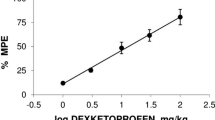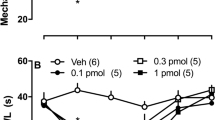Abstract
Previously it was demonstrated that nitrous oxide antinociception in the mouse abdominal constriction test is mediated by κ-opioid receptors. Since nitrous oxide is thought to cause the neuronal release of endogenous opioid peptide to stimulate opioid receptors, this study was designed to identify the opioid peptides involved, especially in the spinal cord, by determining whether nitrous oxide antinociception can be differentially inhibited by intrathecally (i.t.) administered antisera to different opioid peptides. Male NIH Swiss mice were pretreated i.t. with rabbit antisera to opioid peptides then exposed 24 h later to one of three different concentrations of nitrous oxide in oxygen. Dose-response curves constructed from the data indicated that the antinociceptive effect of nitrous oxide was significantly antagonized by antisera to various dynorphins (DYNs) and methionine-enkephalin (ME), but not by antiserum to β-endorphin (β-EP). The AD50 values for nitrous oxide antinociception were significantly elevated by antisera to DYNs and ME but not β-EP. These findings of this study support the hypothesis that nitrous oxide antinociception in the mouse abdominal constriction test involves the neuronal release of DYN and ME in the spinal cord.
Similar content being viewed by others
References
Berkowitz BA, Ngai SH, Finck AD. Nitrous oxide ‘analgesia’: Resemblance to opiate action. Science 194:967–968;1976.
Berkowitz BA, Finck AD, Hynes MD, Ngai SH. Tolerance to nitrous oxide analgesia in rats and mice. Anesthesiology 51:309–312;1979.
Branda EM, Ramza JT, Cahill FJ, Tseng LF, Quock RM. Role of brain dynorphin in nitrous oxide antinociception in mice. Pharmacol Biochem Behav 65:217–221;2000.
Chavkin C, James IF, Goldstein A. Dynorphin is a specific endogenous ligand of the κ-opiate receptor. Science 215:413–415;1982.
Corbett AD, Paterson SJ, McKnight AT, Magnan J, Kosterlitz HW. Dynorphin (1–8) and dynorphin (1–9) are ligands for the κ-subtype of opiate receptor. Nature 299:79–81;1982.
Dewey WL, Harris LS, Howes JF, Nuite J. The effect of various neurohumoral modulators on the activity of morphine and the narcotic antagonists in the tail-flick and phenylquinone tests. J Pharmacol Exp Ther 175:435–442;1970.
Höllt V, Przewlocki R, Herz A. Radioimmunoassay of β-endorphin: Basal and stimulated levels in extracted rat plasma. Naunyn Schmiedebergs Arch Pharmacol 303:171–174;1978.
Hylden JL, Wilcox GL. Intrathecal morphine in mice: A new concept. Eur J Pharmacol 167:313–316;1980.
Hynes MD, Hymson DL. Nitrous oxide generalizes to a discriminative stimulus produced by ethylketocyclazocine but not morphine. Eur J Pharmacol 105:155–159;1984.
Kripke BJ, Hechtman HB. Nitrous oxide for pentazocine addiction and for intractable pain: Report of case. Anesth Analg 51:520–527;1972.
Litchfield JT, Wilcoxon F. A simplified method of evaluating dose-effect experiments. J Pharmacol Exp Ther 96:99–108;1949.
Mizoguchi H, Narita M, Kampine JP, Tseng LF. [Met5]enkephalin and δ2-opioid receptors in the spinal cord are involved in the cold water swimming-induced antinociception in the mouse. Life Sci 61:PL81–86;1997.
Quock RM, Best JA, Chen DC, Vaughn LK, Portoghese PS, Takemori AE. Mediation of nitrous oxide analgesia in mice by spinal and supraspinal κ-opioid receptors. Eur J Pharmacol 175:97–100;1990.
Quock RM, Curtis BA, Reynolds BJ, Mueller JL. Dose-dependent antagonism and potentiation of nitrous oxide antinociception by naloxone in mice. J Pharmacol Exp Ther 267:117–122;1993.
Quock RM, Graczak LM. Influence of narcotic antagonist drugs upon nitrous oxide analgesia in mice. Brain Res 440:35–41;1988.
Quock RM, Mueller J. Protection by U-50, 488H against β-chlornaltrexamine antagonism of nitrous oxide antinociception in mice. Brain Res 549:162–164;1991.
Quock RM, Vaughn LK. Nitrous oxide: Mechanism of its analgesic action. Analgesia 1:151–159;1995.
Tseng LF, Collins KA. Spinal involvement of both dynorphin A and metenkephalin in the antinociception induced by intracerebroventricularly administered bremazocine but not morphine in the mouse. J Pharmacol Exp Ther 266:1430–1438;1993.
Tyers MB. A classification of opiate receptors that mediate antinociception in animals. Br J Pharmacol 69:503–512;1980.
Xu JY, Tseng LF. [Met5]enkephalin in the spinal cord is involved in the antinociception induced by intracerebroventricularly-administered etorphine in the mouse. Neuroscience 80:579–585;1997.
Author information
Authors and Affiliations
Rights and permissions
About this article
Cite this article
Cahill, F.J., Ellenberger, E.A., Mueller, J.L. et al. Antagonism of nitrous oxide antinociception in mice by intrathecally administered antisera to endogenous opioid peptides. J Biomed Sci 7, 299–303 (2000). https://doi.org/10.1007/BF02253248
Received:
Accepted:
Issue Date:
DOI: https://doi.org/10.1007/BF02253248




